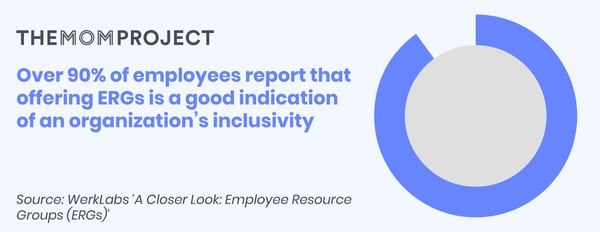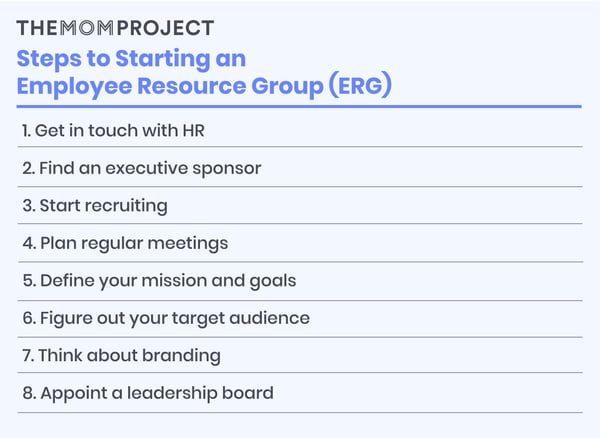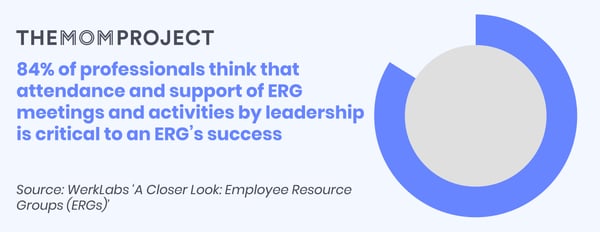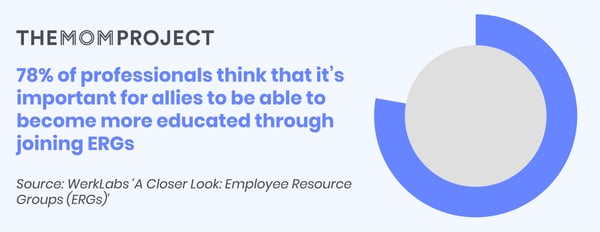With all of the time and effort you put into your work, it’s natural to crave deeper connections at the office. And while it’s valuable to learn how to communicate and interact with your colleagues from different backgrounds and identities, you can still want to connect with people at work who share your experiences and struggles.
Employee Resource Groups (ERGs), sometimes referred to as Diversity, Affinity or Inclusion Groups, are a safe space for employees with shared characteristics or experiences to come together as a community and provide support within an organization. ERGs are essentially in-house clubs where employees can meet to discuss relevant topics, set goals of what they’d like to accomplish as a group and host company-wide events related to their mission.
Whether you feel like you need some support from like-minded people, or you’d like to be an ally for other communities, many of us can benefit from participating in an ERG. However, a recent report by WerkLabs found that only 42% of professionals are familiar with the concept of employee resource groups.

So let’s talk about what you need to know about ERGs—the highs, the lows and how you can get involved.

The Mom Project's Employee Resources Group (ERG) Guide
- What kind of ERGs are out there?
- How can ERGs be valuable?
- Why should you join an ERG?
- How to start an ERG
- 5 Ways to make the most of your ERG
- Addressing challenges
- Notable impact of ERGs
- Limitations of ERGs
What kind of ERGs are out there?
Employee resource groups can vary widely by company. The original ERG was created in the 1960s by Joseph Wilson, the CEO of the Xerox Corporation, who started a black employee forum to fight discrimination in the workplace in response to the 1964 race riots in Rochester, NY.
True to their origins, some organizations reserve the ERG title for historically underrepresented groups, including LGBTQ+, women, Latinx, African Americans and differently-abled employees. However, many companies also recognize identities that aren’t necessarily traditionally marginalized but can still benefit from alliances in the workplace.
In some companies, the ERG label can also be extended to special interest groups, like organizations for those pursuing meditation and yoga, volunteering or environmental sustainability. While these are a bit of a divergence from the program’s traditional roots and aren’t quite as universal from company to company, they can still benefit their members and serve the function of ERGs.
How can ERGs be valuable?
Benefits for employees
- Create a safe space to talk about common struggles and experiences
- Give employees a support group of those experiencing similar challenges
- Give participants an opportunity to meet with senior leadership and connect with colleagues across different parts of the company
- Allow members to brainstorm and pursue actionable solutions to challenges, including instituting new policies or benefits
- Provide educational opportunities to engage allies
Benefits for employers
- Create a sense of community and belonging for employees, improving employee satisfaction and retention
- Empower employees by allowing them to speak with decision-makers about issues that matter to them, lowering the chance of suppressed frustrations and bitterness against company leadership
- Increase cultural awareness among the rest of the staff through allyship opportunities and educational talks
- Identify leadership potential among employees and provide professional development opportunities for promising candidates
- Provide a resource for leadership to make decisions about community needs and employee policies

Why should you join an ERG?
Joining an employee resource group can be a great opportunity to meet new people and contribute to a meaningful cause outside of your day-to-day work. Whether you’re just starting out at the company and looking to make friends or you’ve been there for a while, it can be refreshing to meet colleagues outside your own team and connect with people in varying levels and departments.
It can also give you a chance to gain leadership experience by stepping up and making an impact, from leading discussions to collaborating with the group on new initiatives. The meetings, events and work that you do for the group can also break up your day and give you some intermittent relief from your typical responsibilities.
👉 Participating on the board of an ERG can also give you a chance to try out a different line of business. For example, if you work full-time as an engineer but you’ve always been curious about marketing, this can be your chance to give it a shot.
How to start an Employee Resource Group
If the community you want doesn’t exist at your company yet, not to worry! You can be the one to take action and create a space to welcome moms, women of color or whatever group you’d like to connect with.

Get in touch with HR
Set up a meeting with your human resources contact to find out the requirements for starting an ERG at your workplace. Do you have a budgetary ask? Budgeting for ERGs is different wherever you work, so be prepared to discuss your needs and expectations. According to a Mercer study, the average annual budget for ERGs is $7,203 per 100 members, but it varies by company. Make sure to consider your potential costs beforehand—food for events, educational resources, etc.
If the budget you’re offered isn’t sufficient to cover what you’d like to accomplish, you can also fundraise later on down the line, and revisit your ask once your group has had the chance to measure its impact.
Find an executive sponsor
Most companies require their ERGs to have an executive sponsor such as a senior member of leadership who’s actively involved in the organization, and some will even assign them for you. Your executive sponsor can be a useful member or ally to help advocate for organizational change for your group and make sure that your requests make it to the decision-makers. While some ERGs prefer an executive sponsor who can identify with the group, it can also be useful to partner with an ally who can bring their own perspective—it all comes down to what your organization democratically decides is best.

Start recruiting
Get the word out about your group using all of the channels your company uses—advertise on Slack, Microsoft Teams, your company news feed, a mass email, all-hands meetings or even posters in common spaces. You can usually call on the HR department to help with outreach too. if the company keeps an updated list of ERGs, make sure they add your group, along with your mission, goals and contact information to make you accessible to any prospective members now and in the future.
Plan regular meetings
Decide what kind of group you want to be. Are you gathering in the break room before the workday starts to meet for coffee? Will you be chatting virtually over lunch? After you’ve established that, schedule a regular meeting time for members to discuss relevant topics, plan events for the company and think about what initiatives to pursue as a group.

Define your mission and goals
First, draft a statement to define why your group was made and decide what you’re trying to accomplish.
For example, our African-American ERG at The Mom Project has the mission statement: “To provide support for the advancement of Black and Brown People within TMP. We aim to elevate and add more black and brown voices within the organization.”
It’s enough to just want to create a safe space for a community, but if your group is prepared to invest more time and effort, you can come up with a list of ways to improve your group’s experience in the workplace. You can also include some internal goals for how you hope to benefit your members, as well as some larger objectives of how you plan to influence the company and the industry it’s in.
For example, if you’re running an ERG for moms, you can say that your group aims to bring awareness to challenges that moms face, such as the childcare crisis. This can be further broken down into individual objectives, like convincing leadership to create designated mother’s rooms, subsidize child care costs and offer fertility benefits.
Figure out your target audience
Who’s the group for? How specific do you want it to be? If you’re trying to start a group for moms, would you be interested in opening it up to all parents, or should dads have a separate group? The WerkLabs ERG study found that nearly 70% of respondents prefer that ERGs be overly specialized than more general. But if your company is small or has budget constraints, you might need to start with a broader demographic and then reconfigure as your company grows. Salesforce, for example, started with an Asian ERG, which later splintered into Asiapacforce (cultures from the Asian Pacific region and Southasiaforce (for cultures from the South Asian region) as the program grew.

Think about branding
Brainstorm some ideas for design and writing style to use on posters and marketing materials. You might want to appoint a head of marketing or design to create some style guides once you have your team assembled. In the meantime, however, you can just use templates from websites like Canvas or Evite.
Determine the role of allies
Figure out what your group needs from your allies so you can clearly communicate your expectations and boundaries. Your allies are there to educate themselves and support your cause, and they want to know how they can best do that.
While it’s often a good idea to include allies in your meetings and discussions, it’s okay to prioritize the comfort and needs of your group’s core members. Decide when to invite your allies and when it’s appropriate to have a closed door. You can make certain topics open only to members who identify with the group, you can make every other meeting open to allies or any other system that works for your group.

Appoint a leadership board
Once you’ve had a meeting or two and can accurately gauge interest in the group, figure out who can commit some time weekly or monthly to plan meetings and events. Make expectations for each role very clear so that applicants know what’s expected of them. Representation is also crucial for your ERG to function, so if there’s an abundance of interest in leadership positions, facilitate a democratic decision by holding a vote.
5 Ways to make the most of your ERG
1. Partner with organizations
Scope out some organizations that align with your mission and reach out to them about partnering. Partnerships can improve your capacity for outreach and allow you to make a difference in the larger community. Getting in touch with speakers and organizations can also give you more volunteering opportunities and ideas for programming.
2. Open select events to all employees
While you should focus on making your employee resource group a safe space for members, it can also be helpful to open select events to all employees. Even if your ERG’s regular meetings are open to members only, you can work with your HR team to host company-wide speaker events or organize a volunteer opportunity and give all employees the option to attend. Even if allies are just there to ask questions, listen and learn, they can be influential in moving your initiatives forward and spreading awareness for your cause.
3. Measure the group's impact
Decide on some metrics that you’ll use to measure your group’s effectiveness. You can record attendance at meetings or events, employee retention rates during the time that you’ve been in operation and survey responses about the organization. It’s also a good idea to track your progress on internal and external goals, like raising money for an organization that shares your mission, instituting policy changes or aiding in employee recruitment efforts. Then you can prepare a quarterly or annual report to show company leadership the value of your organization. This document can come in handy especially when negotiating valuable resources that your ERG needs.
4. Collaborate with other ERGs
It can be tempting to see other employee resource groups as competition for funding and resources, but employee resource groups are often more effective when working together. Designate someone in your group to talk to HR and other ERG leaders about brainstorming initiatives for the organizations to support one another. If it’s appropriate, coordinate collaborative events with other ERGs to boost attendance and explore issues from an intersectional perspective.
👉 Keep track of when other ERG have their events so you don’t have to worry about conflicts or making employees choose between the two.
5. Explore low-budget programming options
Not every company grants a sustained budget to run employee resource groups, and even if your organization does get an annual or quarterly grant, it doesn’t always cover everything that you want to do. But the good news is that you don’t need a lot of money to build a strong community or to make an impact.
Take advantage of activities that will engage your members with minimal to no cost, including:
- Group discussions about relevant topics
- Book clubs
- Mentorship programs
- Speaker events
Addressing challenges
Adjusting to remote work
Operating remotely can pose new challenges for many employee resource groups. While you may be used to gathering in a meeting room and discussing topics face-to-face, remote work means shifting that all to a virtual setting. And although ERGs can be an important source of support during this time, it’s also important to recognize that everyone may have a lot more on their plate than usual.
Take it easy on yourself, relax your expectations and deadlines, and take on only as much as you can handle. Try to get an idea of everyone’s bandwidth so this doesn’t become a stressful commitment for you and your members.
👉 If your group has the time and ability, consider setting up virtual support groups and events geared specifically toward struggles that people might be dealing with right now.
Set boundaries for your time
It can be easy to let your responsibilities within the group cut into the rest of your work obligations—especially if you’re taking on a leadership role within your ERG. Set clear boundaries and limits for what you’re able to take on, and be open to asking the rest of your team for help when you need it.
You’re also going to want to talk with your manager about the decision to join or lead an employee resource group, and figure out what that means for your schedule and overall workload.
On the other hand, if you hold a more senior role at your company and manage employees who want to participate in ERGs, try to work collaboratively with them to figure out how to support their efforts.
Think about scalability
Just like in any new organization, new challenges may arise as your group grows. As new members come in, they may bring different ideas, perspectives and various levels of participation and expectations. Not to mention a bigger group just means you have to keep track of more people. As soon as you can, try to come up with a process to respond to ideas and feedback from the group.
👉 Be open to making adjustments to your workflow as your organization grows—what works for 50 people won’t always work for 1,000.
Think about succession planning when assigning leadership roles. It’s important to make sure everything is well-documented, from partnership contacts to style guides. You can also try to distribute tasks and responsibilities to several members so that knowledge can be spread out among the team. And when leaders step down from their positions, seek out a replacement to transition in.
Notable impact of ERGs
Especially during challenging times, employee resources groups have an opportunity to make a big difference within their companies, field and industry.
Here are some examples of some groups that have stepped up:
Offering support during remote work
- The ERG network at Barilla organized virtual focus groups for their employees all over the world to listen to their concerns, identify at-risk groups and ask for ideas on how best to support them. Then they used the information they gathered to develop local programs to support employees in areas that they found needed them the most.
- FINRA, the Financial Industry Regulatory Authority, used its array of ERGs to support employees’ various needs:
- DAWN, the disability and wellness group, provided wellness resources like virtual sessions about handling challenges of remote work, articles about maintaining mental and physical health, and a guided meditation series
- FPN, the Parents Network, offered resources for parents working remotely, like tips and ideas to keep kids occupied while they’re home and how to discuss COVID and social issues
- FWN, the Women’s Network, extended group sessions and support like Women’s Circle events to facilitate informal mentoring, networking and sharing experiences and advice
Being a resource for the rest of the company
Reddit, the social news website, recruited its Black People Reddit ERG to write a letter to employees about the significance of Juneteenth, and to provide resources on how to practice allyship and learn more.
Leading the company's public efforts
- In the wake of the murder of George Floyd, Nordstrom tweeted out a video from its “Courageous Conversations” forum set up by its Black Employee Network.
- Starbucks enlisted their Black Partner Network to co-design t-shirts in support of BLM.
Limitations of ERGs
While employee resource groups can have a big impact on a company, they’re not a magical fix for diversity and inclusion in the workplace. Typically ERG leaders are volunteering their time and effort, and it’s not fair to expect them to solve the company’s problems in their free time.
Some companies have made up for this by compensating their ERG leaders for their work, either with cash bonuses or by allotting a certain amount of their workday to ERG projects. However, some members think that treating ERG leadership as a job can interfere with motivations and that your involvement in the organization should be a passion project for you.
Ultimately, while ERGs can be a good resource for company leadership to suggest changes that need to be made and potential solutions, the real change needs to be made from the top down.
Going forward
Employee resource groups (ERGs) can be a valuable opportunity to form deeper connections and make a difference at your company. If you’re thinking about getting involved in an ERG or starting one of your own, communicate with your HR department, colleagues and supervisors to figure out the best way to make it work.
It’s more than jobs. We’re making progress.
The Mom Project supports women throughout their working motherhood journey. Search for career opportunities with vetted, family-friendly employers, and get access to job search tools, career development resources and a thriving community of moms and allies. 



